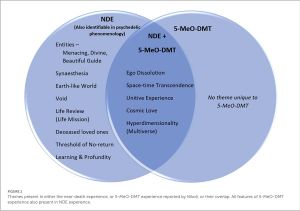Near Death Experience
A near-death experience (NDE) is a profound psychological event that may occur to a person close to death. There are many reported effects experienced during an NDE including transcendental, hallucinogenic and mystical elements which makes them considered a Pivotal Mental State and thought to be comparable to the psychedelic experience brought on by ketamine use. The after effects of NDEs have been widely documented[1] and have been shown to be powerfully life-altering.
Near Death Experience Reporting
As with our referencing policy as of yet there have been no meta analyses of NDE reports. However, analysing published medical documentation there seems to be a some commonality reported during near-death experiences.
- a sense of being outside one’s physical body (Out of Body Experience),
- a sense of movement through darkness or a tunnel
- a sense of oneness and interconnectedness
- experiencing a great light or darkness;
- perceiving a spiritual realm, which may include vividly memorable landscapes;
- encounters with deceased loved ones, spiritual beings and/or religious figures;
- knowledge of the nature of the universe
- a life review
- a border of no return;
- a sense of having knowledge of the future;
- messages regarding life’s purpose.
Near Death Experiences and Psychedelics
There is a growing amount of evidence that suggests that dissociatives such as ketamine[2][3] or classical psychedelics[4] such as DMT[5] or 5MeO-DMT[6] can induce a state similar to NDEs however, historically, a defunct class of drugs called the pseudohallucinogens[7] is also thought to bridge this gap by actually causing a near death experience! These compounds consist of a diverse range of chemicals the effects of which broadly are considered poisonous, these include:
- Nutmeg / mace
- Wisteria sinenis
References
- ↑ International Association for Near-Death Studies - https://iands.org/
- ↑ Anomalous Psychedelic Experiences: At the Neurochemical Juncture of the Humanistic and Parapsychological, Volume 62, Issue 2. Accessed on 15th September 2022 via: https://journals.sagepub.com/doi/full/10.1177/0022167820917767
- ↑ The Ketamine Model of the Near-Death Experience: A Central Role for the N-Methyl-D-Aspartate Receptor. Jansen, K.L.R. Journal of Near-Death Studies 16, 5–26 (1997). https://doi.org/10.1023/A:1025055109480. Accessed on 19 Jul 2023 via https://link.springer.com/article/10.1023/A:1025055109480
- ↑ Within-subject comparison of near-death and psychedelic experiences: acute and enduring effects. Charlotte Martial, Robin Carhart-Harris , Christopher Timmermann. Coma Science Group, GIGA-Consciousness, University of Liège, Liège, Belgium. Published August 2024
- ↑ DMT Models the Near-Death Experience. Christopher Timmermann1,2*, Leor Roseman1,2, Luke Williams1, David Erritzoe1, Charlotte Martial3, Héléna Cassol3, Steven Laureys3, David Nutt1 and Robin Carhart-Harris. Front. Psychol., 15 August 2018 | https://doi.org/10.3389/fpsyg.2018.01424
- ↑ This is your brain on death: a comparative analysis of a near-death experience and subsequent 5-Methoxy-DMT experience. Pascal Michael, David Luke and Oliver Robinson Front. Psychol., 29 June 2023 Sec. Theoretical and Philosophical Psychology Volume 14 - 2023 | https://doi.org/10.3389/fpsyg.2023.1083361. Accessed on 19 Jul 2023 via https://www.frontiersin.org/articles/10.3389/fpsyg.2023.1083361/full
- ↑ Hallucinogenic Plants. Schultes, Richard Evans (1976). illus. Elmer W. Smith. New York: Golden Press. ISBN 0-307-24362-1.
